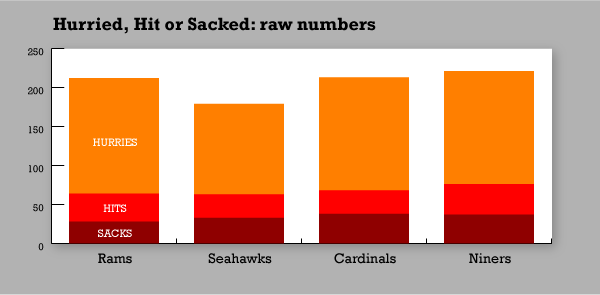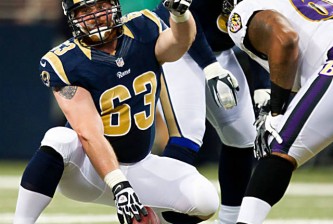He may have just finished his first season in the NFL, but already Sam Bradford is the only quarterback close to being a “sure thing” as starter in the NFC West.
The Seahawks may or may not bring back Matt Hasselbeck (probably not), may or may not ride with Charlie Whitehurst (again, probably not but you never know). The 49ers gave a playbook to Alex Smith, even though he isn’t under contract — can’t be signed to a contract as long as this lockout continues. And they may or may not have their future in Colin Kaepernick. And the Cardinals appear to be ready to nuke their internal options and a big chunk of their draft future in exchange for Kevin Kolb.
While each of these teams is hungry for help under center, each of them — including the Rams — have uncertainties lining up next to center. Whether you’re starting a rookie or bringing in a new veteran, the most important thing you can do to ensure offensive success is to keep him upright. Even as their team’s record was crashing and burning, the Rams’ braintrust knew this and was busily laying groundwork for an offensive rennaisance by investing heavily in Jacob Bell, Jason Brown, Jason Smith and Rodger Saffold before considering starting anew with Bradford.
How did our line do in protecting him? And how ready are our divisional opponents to start fresh with new QB options? Here’s a comparison.

Using statistics from ProFootballFocus, we can see that in terms of raw numbers, the Rams were marginally better than their opponents at preventing sacks — a division-low 28 were “charged” to the offensive line. However, Bradford was “hurried” and hit as much as any QB under center this year. Not the kind of results we should expect, considering how much more solid our line is supposed to be, as compared to our counterparts.
However, we also need to consider that the Rams were one of the pass-heaviest teams in the league last year, with Bradford dropping back to throw a record number of times for an NFL rookie. While Pat Shurmur kept the offense close and conservative, presumably for his young quarterback’s benefit, he wasn’t shy about putting the onus on the rookie to win or lose games for the Rams.
Keeping that in mind, let’s look at these numbers on a per-pass basis.
Now we’re starting to get somewhere. The Rams have the lowest sack rate in the division, and even their hit rate fares pretty well. However, Bradford was “hurried” quite often: throwing the ball with a hand in his face, or being forced to take off running before the route tree bears fruit. What makes Bradford so exciting is that he so often used those opportunities to extend plays and come away with thrilling results, like so:
However, these hurries should be a warning sign that the Rams continue to need help up front. (Particularly at the right guard position, where debate over the prospects of John Greco reigns).
Compare, though, the hurry rate and hit rate in the chart above between the rookie-led Rams and the veteran-led Seahawks. Matt Hasselbeck has been under center long enough, and been battered around in the pocket long enough, that his sixth sense for pocket pressure is now a finely-tuned survival mechanism. Whether it’s a better awareness for sniffing out blitzes, a quicker release to his hot read, or a greater willingness to simply throw the ball away in exchange for a new down, Hasselbeck was able to make a pretty bad offensive line look like it was giving pretty good protection.
As we’ll look at in our Rams Rewind series, this is a skill that Bradford made visible improvements in over the course of the season, but as these numbers show, he still has a long way to go.
The nice section: Today is Laurent Robinson’s birthday, and what better way to celebrate than to re-congratulate him for catching Bradford’s first ever NFL touchdown pass.
























